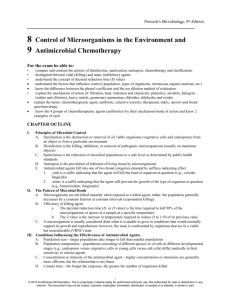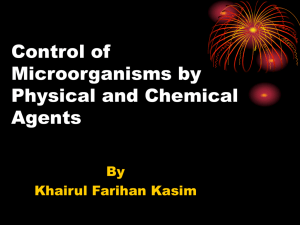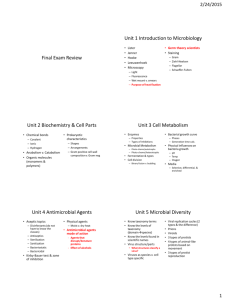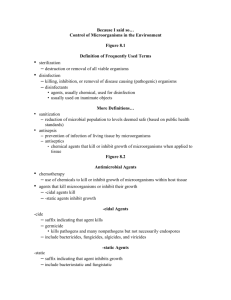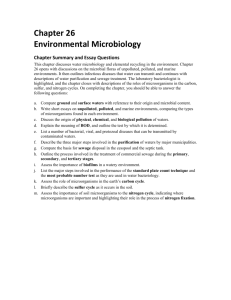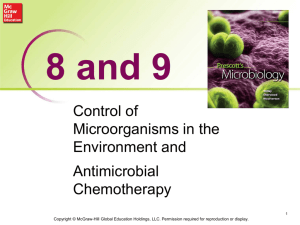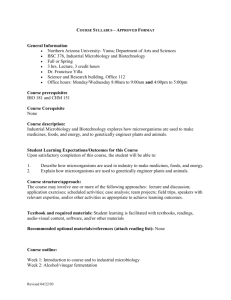Chapter Web Links - mikrobiol unsoed
advertisement
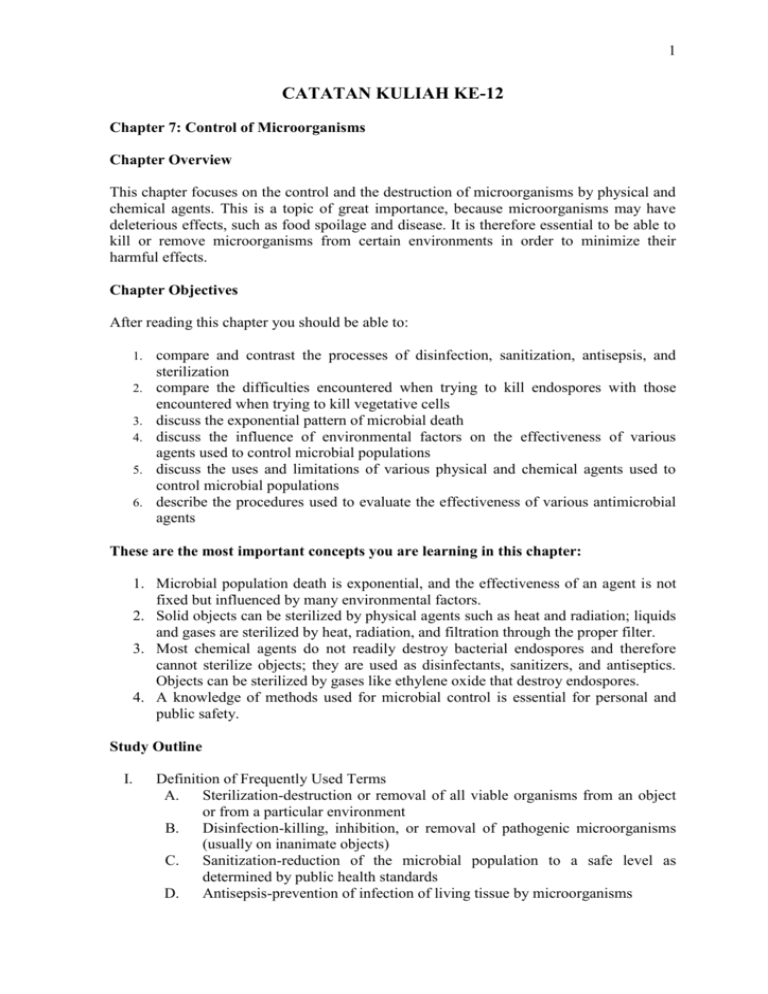
1 CATATAN KULIAH KE-12 Chapter 7: Control of Microorganisms Chapter Overview This chapter focuses on the control and the destruction of microorganisms by physical and chemical agents. This is a topic of great importance, because microorganisms may have deleterious effects, such as food spoilage and disease. It is therefore essential to be able to kill or remove microorganisms from certain environments in order to minimize their harmful effects. Chapter Objectives After reading this chapter you should be able to: 1. 2. 3. 4. 5. 6. compare and contrast the processes of disinfection, sanitization, antisepsis, and sterilization compare the difficulties encountered when trying to kill endospores with those encountered when trying to kill vegetative cells discuss the exponential pattern of microbial death discuss the influence of environmental factors on the effectiveness of various agents used to control microbial populations discuss the uses and limitations of various physical and chemical agents used to control microbial populations describe the procedures used to evaluate the effectiveness of various antimicrobial agents These are the most important concepts you are learning in this chapter: 1. Microbial population death is exponential, and the effectiveness of an agent is not fixed but influenced by many environmental factors. 2. Solid objects can be sterilized by physical agents such as heat and radiation; liquids and gases are sterilized by heat, radiation, and filtration through the proper filter. 3. Most chemical agents do not readily destroy bacterial endospores and therefore cannot sterilize objects; they are used as disinfectants, sanitizers, and antiseptics. Objects can be sterilized by gases like ethylene oxide that destroy endospores. 4. A knowledge of methods used for microbial control is essential for personal and public safety. Study Outline I. Definition of Frequently Used Terms A. Sterilization-destruction or removal of all viable organisms from an object or from a particular environment B. Disinfection-killing, inhibition, or removal of pathogenic microorganisms (usually on inanimate objects) C. Sanitization-reduction of the microbial population to a safe level as determined by public health standards D. Antisepsis-prevention of infection of living tissue by microorganisms 2 E. II. III. IV. Antimicrobial agents fall into one of two broad categories denoted by suffixes indicating effect 1. -cide-a suffix indicating that the agent will kill the kind of organism in question (e.g., viricide, fungicide) 2. -static-a suffix indicating that the agent will prevent the growth of the type of organism in question (e.g., bacteriostatic, fungistatic) The Pattern of Microbial Death A. Microorganisms are not killed instantly when exposed to a lethal agent; rather, the population decreases by a constant fraction at constant intervals (exponential killing) B. A microorganism is usually considered dead when it is unable to grow in conditions that would normally support its growth and reproduction Conditions Influencing the Effectiveness of Antimicrobial Agent Activity A. Population size-larger populations take longer to kill than smaller populations B. Populations consisting of different species or of cells at different developmental stages (e.g., endospores versus vegetative cells or young cells versus old cells) differ markedly in their sensitivity to various agents C. Concentration or intensity of the antimicrobial agent-higher concentrations or intensities are generally more efficient, but the relationship is not linear D. Duration of exposure-the longer the exposure, the greater the number of organisms killed E. Temperature-a higher temperature will usually (but not always) increase the effectiveness of killing F. Local environment-environmental factors, such as pH, viscosity, and concentration of organic matter can profoundly influence the effectiveness of a particular antimicrobial agent The Use of Physical Methods in Control A. Heat 1. Measuring heat killing efficiency a. The thermal death time (TDT) is the shortest time necessary to kill all microorganisms in a suspension at a specific temperature and under defined conditions b. The decimal reduction time (D, or D value) is the time required to kill 90% of the microorganisms or spores in a sample at a specific temperature c. The Z value is the increase in temperature required to reduce D to 1/10 of its previous value d. The F value is the time in minutes at a specific temperature (usually 250ºF or 121.1ºC) necessary to kill a population of cells or spores 2. Killing with moist heat a. Boiling water is effective against vegetative cells and eucaryotic spores b. Autoclaving (steam under pressure) is effective against vegetative cells and most bacterial endospores c. Pasteurization, a process involving brief exposure to temperatures below the boiling point of water, reduces the total microbial population and thereby increases the shelf life of the treated material; it is often used for heat-sensitive 3 V. materials that cannot withstand prolonged exposure to high temperatures 1. Low-temperature long-term (LTLT) pasteurization63ºC for 30 min 2. High-temperature short-term (HTST) flash pasteurization-72ºC for 15 sec 3. Ultrahigh temperature (UHT) pasteurization-140º to 150ºC for 1 to 3 sec 3. Dry heat can be used to sterilize moisture-sensitive materials such as powders, oils, and similar items; it is less efficient than moist heat because it usually requires higher temperatures (160º to 170ºC) and longer exposure times (2 to 3 hours) B. Low temperatures-these slow (refrigeration) or prevent (freezing) microbial growth and reproduction, but do not necessarily kill microorganisms; refrigeration and freezing are particularly important in food microbiology C. Filtration-sterilizes heat-sensitive liquids and gases by removing microorganisms rather than destroying them 1. Depth filters are thick fibrous or granular filters that remove microorganisms by physical screening, entrapment, and/or adsorption 2. Membrane filters are thin filters with defined pore sizes that remove microorganisms, primarily by physical screening 3. High-efficiency particulate air (HEPA) filters are used in laminar flow biological safety cabinets to sterilize the air circulating in the enclosure D. Radiation 1. Ultraviolet (UV) radiation is effective, but its use is limited to surface sterilization because UV radiation does not penetrate glass, dirt films, water, and other substances 2. Ionizing radiation (X rays, gamma rays, etc.) is effective and penetrates the material; the Food and Drug Administration and the World Health Organization have approved food irradiation and declared it safe; however, it is not widely used because of cost and concerns about the effects of the radiation on food The Use of Chemical Agents in Control A. Phenolics-laboratory and hospital disinfectants; act by denaturing proteins and disrupting cell membranes B. Alcohols-widely used disinfectants and antiseptics; will not kill endospores; act by denaturing proteins and possibly by dissolving membrane lipids C. Halogens-widely used antiseptics and disinfectants; iodine acts by oxidizing cell constituents and iodinating cell proteins; chlorine acts primarily by oxidizing cell constituents D. Heavy metals-effective but usually toxic; act by combining with proteins and inactivating them E. Quaternary ammonium compounds-cationic detergents used as disinfectants for food utensils and small instruments, and because of low toxicity, as antiseptics for skin; act by disrupting biological membranes and possibly by denaturing proteins F. Steri G. Aldehydes-reactive molecules that can be used as chemical sterilants; may irritate the skin; act by combining with nucleic acids and proteins and inactivating them lizing gases (e.g., ethylene oxide, betapropiolactone)-can 4 be used to sterilize heat-sensitive materials such as plastic petri dishes and disposable syringes; act by combining with proteins and inactivating them; recently, vapor-phase hydrogen peroxide has been used to decontaminate biological safety cabinets VI. Evaluation of Antimicrobial Agent Effectiveness A. The phenol coefficient test is a useful initial screening test in which the potency of a disinfectant is compared to that of phenol B. A more realistic test is the use of a dilution test; in this test, stainless steel cylinders are contaminated with specific bacterial species under carefully controlled conditions and then exposed to the disinfectant Chapter Web Links Sterilization or Disinfection of Medical Devices: General Principles. (http://www.cdc.gov/ncidod/diseases/hip/sterilgp.htm) From the Centers for Disease Control. Food and Water Precautions and Travelers' Diarrhea. CDC Travel Information (http://www.cdc.gov/travel/foodwatr.htm) The Bad Bug Book (http://vm.cfsan.fda.gov/~mow/intro.html) Bacteria and Other Microorganisms in Household Water (http://www.cdc.gov/niosh/nasd/docs4/va98020.html) Cleaning and disinfection of the child-care environment (http://www.cdc.gov/ncidod/hip/abc/practic9.htm) Chapter 35: Antimicrobial Chemotherapy Chapter Overview The control or the destruction of microorganisms that reside within the bodies of humans and other animals is of tremendous importance. This chapter introduces the principles of chemotherapy and discusses the ideal characteristics for successful chemotherapeutic agents (including the concept of selectively damaging the target microorganism while minimizing damage to the host). The chapter also presents characteristics of some commonly used antibacterial, antifungal, and antiviral drugs Chapter Objectives After reading this chapter you should be able to: 1. discuss the various ways in which antimicrobial agents can damage pathogens while causing minimal damage to the host 5 discuss the various factors that influence the effectiveness of a chemotherapeutic agent 3. discuss the increasingly serious problem of drug-resistant pathogens 4. discuss the increasing demand for and availability of antifungal and antiviral agents 2. These are the most important concepts you are learning in this chapter: 1. The science of epidemiology deals with the occurrence and distribution of disease within a given population. Infectious disease epidemiology is concerned with organisms or agents responsible for the spread of infectious diseases in human and other animal populations. 2. Because numbers and time are major epidemiological parameters, statistics is an important working tool in this discipline. Statistics is used to determine morbidity, frequency, and mortality rates. 3. To trace the origin and manner of spread of an infectious disease outbreak, it is necessary to learn what pathogen is responsible. 4. Epidemiologists investigate five links in the infectious disease cycle: (1)characteristics of the pathogen, (2) source and/or reservoir of the pathogen, (3) mode of transmission, (4) susceptibility of the host, and (5) exit mechanisms. 5. The control of nosocomial (hospital) infections has received increasing attention in recent years because of the number of individuals involved, increasing costs, and the length of hospital stays. Study Outline I. II. III. Introduction A. Chemotherapeutic agents are chemical agents used to treat disease B. Antibiotics are microbial products or their derivatives that kill or inhibit susceptible microorganisms C. Synthetics-drugs that are not microbially synthesized The Development of Chemotherapy A. Paul Ehrlich (1904-1909)-aniline dyes and arsenic compounds B. Gerhard Domagk, and Jacques and Therese Trefouel (1939)-sulfanilamide C. Ernest Duchesne (1896) discovered penicillin; however, this discovery was not followed up and was lost for 50 years D. Alexander Fleming (1928) accidentally discovered the antimicrobial activity of penicillin on a contaminated plate; however, follow-up studies convinced him that penicillin would not remain active in the body long enough to be effective E. Howard Florey and Ernst Chain (1939) aided by the biochemist, Norman Heatley, worked from Fleming's published observations, obtained a culture from him, and demonstrated the effectiveness of penicillin F. Selman Waksman (1944)-streptomycin; this success led to a worldwide search for additional antibiotics, and the field has progressed rapidly since then General Characteristics of Antimicrobial Drugs A. Selective toxicity-ability to kill or inhibit microbial pathogen with minimal side effects in the host 6 1. IV. V. VI. Therapeutic dose-the drug level required for clinical treatment of a particular infection 2. Toxic dose-the drug level at which the agent becomes too toxic for the host (produces undesirable side effects) 3. Therapeutic index-the ratio of toxic dose to therapeutic dose: the larger the better B. Drugs with narrow spectrum activity are effective against a limited variety of pathogens; drugs with broad-spectrum activity are effective against a wide variety of pathogens C. Chemotherapeutic agents can occur naturally, be synthetic, or semisynthetic (chemical modifications of naturally occurring antibiotics) D. Drug can be cidal (able to kill) or static (able to reversibly inhibit growth) E. Minimal inhibitory concentration (MIC) is the lowest concentration of the drug that prevents growth of a pathogen; minimal lethal concentration (MLC) is the lowest drug concentration that kills the pathogen Determining the Level of Antimicrobial Activity A. Dilution susceptibility tests-a set of broth-containing tubes are prepared; each tube in the set has a specific antibiotic concentration; a standard number of test organisms is added to each 1. The lowest concentration of the antibiotic resulting in no microbial growth is the MIC 2. Tubes showing no growth are subcultured into tubes of fresh medium that do not contain antibiotic to determine the lowest concentration of the drug from which the organism does not recover; this is the MLC B. Disk diffusion tests-disks impregnated with specific drugs are placed on agar plates inoculated with the test organism; clear zones (no growth) will be observed if the organism is sensitive to the drug; the size of the clear zone is used to determine the relative sensitivity according to tables prepared for the various available drugs; zone width is a function of initial concentration, solubility, and diffusion rate of the antibiotic C. Measurement of drug concentrations in the blood can be done using microbiological, chemical, immunological, enzymatic, and/or chromatographic assays Mechanisms of Action of Antimicrobial Agents A. Inhibition of cell wall synthesis B. Inhibition of protein synthesis C. Inhibition of nucleic acid synthesis D. Disruption of cell membranes E. Inhibition of metabolic activities (antimetabolites) Factors Influencing the Effectiveness of Antimicrobial Drugs A. Drug's ability to reach the site of infection-this is greatly influenced by the mode of administration (e.g., oral, topical, parenteral), but can also be influenced by exclusion from the site of infections (e.g., blood clots or necrotic tissue protects bacterium) B. Susceptibility of pathogen-influenced by growth rate and by inherent properties (e.g., whether or not pathogen has target of the drug) C. Factors influencing drug concentration in the body-must exceed the pathogen's MIC for the drug to be effective; this will depend on 1. Amount of drug administered 7 VII. VIII. 2. Route of administration 3. Speed of uptake 4. Rate of clearance (elimination) from the body D. Drug resistance has become an increasing problem Antibacterial Drugs A. Sulfonamides or sulfa drugs-structural analogues of metabolic intermediates; they inhibit folic acid synthesis in bacteria (humans don?t synthesize folic acid, so are not affected); resistance is increasing and many patients are allergic to these drugs B. Quinolones-inhibit bacterial DNA gyrase, thereby disrupting replication, repair, and other processes involving DNA C. Penicillins-inhibit cell wall synthesis; many types have been identified or synthesized; they differ in spectrum of activity and administration route; resistance is an increasing problem; some patients are allergic to these antibiotics D. Cephalosporins-inhibit cell wall synthesis, broad spectrum of activity; they can be given to some patients with penicillin allergies E. Tetracyclines-inhibit protein synthesis; broad spectrum F. Aminoglycosides-inhibit protein synthesis; quite toxic to patients G. Erythromycin and other macrolides-inhibit protein synthesis; broad spectrum H. Vancomycing and teicoplanin-glycopeptide antibiotics that block peptidoglycan synthesis I. I. Chloramphenicol-inhibits protein synthesis; it has a broad spectrum but is toxic Drug Resistance A. Mechanisms of drug resistance 1. Prevent entrance of drug (e.g., alter drug transport into cell) 2. Pump the drug out of the cell once it has entered 3. Enzymatic inactivation of the drug-chemical modification of the drug by cellular enzymes can render it inactive before it has a chance to damage the cell 4. Alteration of target enzyme or organelle-modification of the target so that it is no longer susceptible to the action of the drug 5. Use of alternative pathways and increased production of the target metabolite have been used by some organisms to minimize the effects of the drug B. The origin and transmission of drug resistance 1. Spontaneous mutations in chromosomal genes; these are then inherited by progeny of the resistant mutant 2. Transfer of R plasmids 3. Superinfection-growth of drug-resistant pathogens as the result of extensive drug treatment 4. Several strategies can be used to discourage emergence of drug resistance (e.g., administration of high doses, simultaneous treatment with two different drugs, limited use of broad-spectrum antibiotics 5. Drug resistance has become an increasing problem; new drugs are constantly being developed and new treatment methods (e.g., phage treatment of bacterial infections) are being explored 8 IX. X. Antifungal Drugs A. Fungal infections are more difficult to treat than bacterial infections, because the greater similarity between fungi and host limits the ability of a drug to have a selective point of attack; furthermore, many fungi have detoxification systems that inactivate drugs B. Superficial mycoses are infections of superficial tissues and can often be treated by topical application of antifungal drugs such as miconazole, nystatin, and griseofulvin, thereby minimizing systemic side effects C. Systemic mycoses are more difficult to treat and can be fatal; however, amphotericin B and flucytosine have been used with limited success; amphotericin B is highly toxic and must be used with care; flucytosine must be converted by the fungus to an active form, and animal cells are incapable of this; some selectivity is possible, but severe side effects have been observed with both drugs D. Drug resistant fungal strains are also beginning to emerge Antiviral Drugs A. Selectivity has been a problem because viruses use the metabolic machinery of the host B. Antiviral drugs target specific steps of life cycle, especially enzymes that function in the life cycle (e.g., amantadine, vidarabine, acyclovir, and azidothymidine) C. Human interferon is used to treat some viral infections Chapter Web Links Antiviral Drugs For Influenza: The Flu - Facts, Prevention, and Treatment (http://pharmacology.tqn.com/library/weekly/bl980931.htm) Journal of Antimicrobial Chemotherapy Online (http://jac.oupjournals.org/) The Vaccine Page (http://vaccines.com/)
